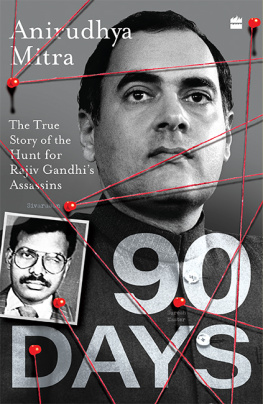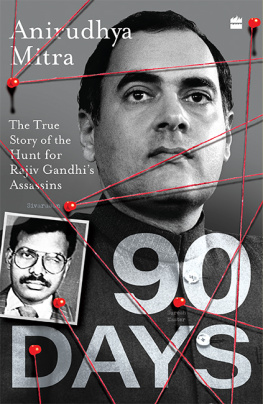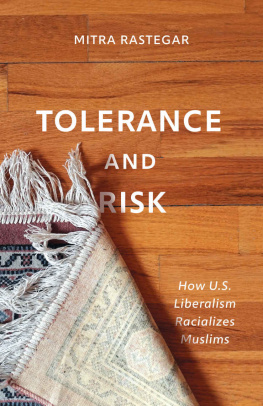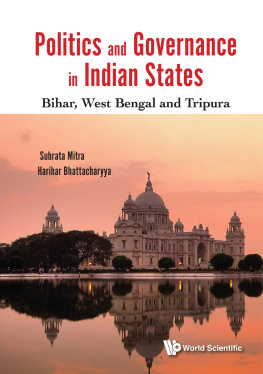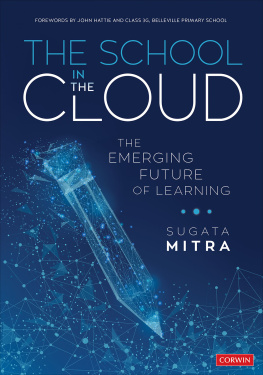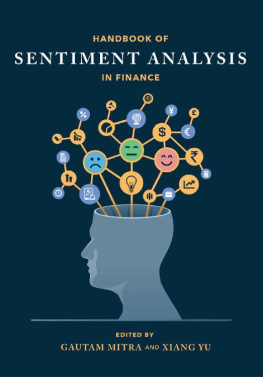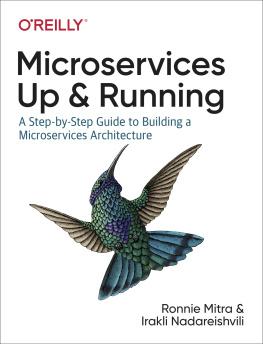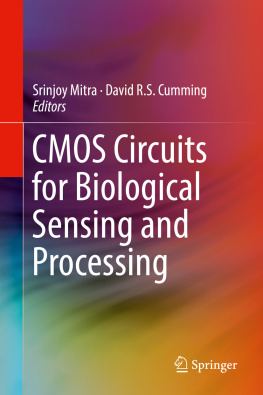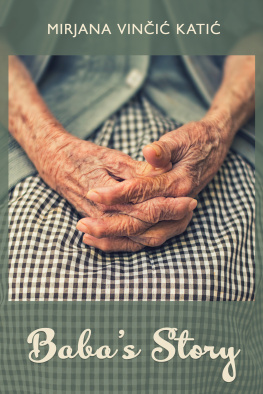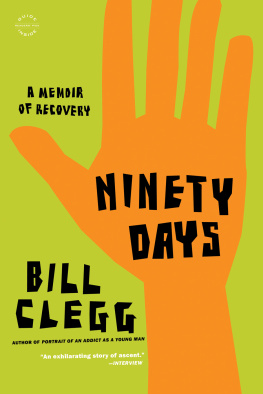Anirudhya Mitra - Ninety Days
Here you can read online Anirudhya Mitra - Ninety Days full text of the book (entire story) in english for free. Download pdf and epub, get meaning, cover and reviews about this ebook. year: 2022, publisher: HarperCollins India, genre: Detective and thriller. Description of the work, (preface) as well as reviews are available. Best literature library LitArk.com created for fans of good reading and offers a wide selection of genres:
Romance novel
Science fiction
Adventure
Detective
Science
History
Home and family
Prose
Art
Politics
Computer
Non-fiction
Religion
Business
Children
Humor
Choose a favorite category and find really read worthwhile books. Enjoy immersion in the world of imagination, feel the emotions of the characters or learn something new for yourself, make an fascinating discovery.
- Book:Ninety Days
- Author:
- Publisher:HarperCollins India
- Genre:
- Year:2022
- Rating:3 / 5
- Favourites:Add to favourites
- Your mark:
- 60
- 1
- 2
- 3
- 4
- 5
Ninety Days: summary, description and annotation
We offer to read an annotation, description, summary or preface (depends on what the author of the book "Ninety Days" wrote himself). If you haven't found the necessary information about the book — write in the comments, we will try to find it.
Ninety Days — read online for free the complete book (whole text) full work
Below is the text of the book, divided by pages. System saving the place of the last page read, allows you to conveniently read the book "Ninety Days" online for free, without having to search again every time where you left off. Put a bookmark, and you can go to the page where you finished reading at any time.
Font size:
Interval:
Bookmark:


To my wife Ruma Mitra, and sons Arjun and Prithvi Mitra.
Pets Bruno, Sasha, Sugar and Whitu.
Contents
R AJIV GANDHI, A FORMER PRIME MINISTER OF INDIA, WAS assassinated on 21 May 1991 at a place called Sriperumbudur in Tamil Nadu. The assassin was an adolescent girl named Dhanu who was made into a human bomb. She got herself exploded at 10.19 p.m. at close proximity with the visiting former Prime Minister. In a trice the life of Rajiv Gandhi was snuffed out and his body smashed into smithereens. As for the assassin, nothing except a few pieces of charred limbs and her sundered head were found. In the explosion, the lives of eighteen others were also extinguished. Investigation pointed to a minutely orchestrated cabal, masterminded by conspirators to extirpate the former Prime Minister from this terrestrial terrain. In the final charge sheet made by the Central Bureau of Investigation (CBI), all the twenty-six appellants now before us were arraigned as members of the conspiracy, which targeted, inter alia, Rajiv Gandhi. The Special Judge who tried the case found all the twenty-six appellants guilty of various offences charged, the gravamen of them being Section 302 read with Section 120-B of the IPC. All of them were hence convicted of those offences and sentenced to death.
Justice K.T. Thomas J.
Supreme Court of India
I TS BEEN THIRTY YEARS THAT I HAVE BEEN ASKING MYSELF WHETHER to write a book on the assassination of Indias former Prime Minister Rajiv Gandhi. It is during these three decades that friends, seniors and government officials have asked me why I have never thought of writing a book even after extensively covering one of the biggest crimes in modern Indian history for the India Today magazine. And when I finally did, the very first question my publisher asked me was why I wrote the book after all these years.
The story Rajiv Assassination: The Inside Story on the 15 July 1991 issue of the India Today magazine had got people talking. While the general response was euphoric, a section of the media felt I was sensationalizing it. The truth is, I had suppressed much more information than I could and had revealed. By the time the Central Bureau of Investigation (CBI) filed the charge sheet, which was eleven months after the assassination, I had a surfeit of concealed facts: the former Prime Ministers assassination was the product of a conspiracy; the plotters and key operators came not just from the Tamil guerrilla separatist organization LTTE (the Liberation Tigers of Tamil Eelam) but had links across the globe. And as the probe gained traction, followed by the seizure of incriminating documents and arrests made, Sivarasan emerged as the mastermind of the complex web that eventually took Rajiv Gandhis life. It became evident that he was regularly in touch with contacts in Singapore, Saudi Arabia, the UAE, Sweden, France and the UK before and after carrying out the assassination.
There have been many theories and conclusions, including the Supreme Court of Indias verdict based on the findings of the CBIs special investigation team (SIT), upholding the death sentence awarded to the assassins. The number of death sentences awarded to the twenty-three accused in the Madras TADA (Terrorist and Disruptive Activities [Prevention] Act) court came down to seven in the Supreme Court but the fate of the key conspirators such as Santhan, Murugan, Nalini and gang remained unaltered. The Jain Inquiry Commission, headed by Justice Milap Chand Jain, set up to look into the larger conspiracy behind the assassination, was flooded with allegations against the P.V. Narasimha Rao government, slowing down the pace of inquiry and ignoring, hiding and suppressing vital evidence that could have led the investigators to the doorstep of some influential people in Delhi. But what nobody could throw light on was Raos motive.
One of the finest officers in the SIT, Amit Verma was later inducted into the commission to assist Justice Jain. Incidentally, Verma had huge differences of opinion with his chief, D.R. Kaarthikeyan, over the possibility of a foreign hand in the assassination. The commission was looking into one Amos Radia and Giorce Betchar as agents operating for the Israelis in India.
And in the days that followed, startling depositions and intelligence intercepts made before the commission indicated that Subramanian Swamy may have had prior knowledge of a threat to Rajiv and had communicated the same to the former Prime Ministers party, but no one, whether in his party or the government, had reacted in a timely manner. In fact, Swamy had had an argument with the then Research and Analysis Wing (R&AW) chief in a Cabinet committee meeting that was held within hours of the killing. Justice Jain devoted separate chapters to three key Indian players who were suspected, one way or the other, to have had prior knowledge of the assassination. The evidence looked more circumstantial, though, but a political will to examine them further was shamelessly ignored by New Delhi.
In my journalism career spanning over ten years, there was no place better than India Today for investigating the Rajiv Gandhi assassination case. It was my greatest experience, the most rewarding and, yes, the most controversial. While India Today backed me to the hilt, there was no dearth of opposition. After the breaking story of how the conspiracy was hatched, a celebrated journalist from a southern daily accused me of yellow journalism, a fellow crime reporter suggested I was writing fiction, a leading politician from Tamil Nadu labelled me anti-Tamil and the LTTE supremo called me an agent of the CBI in his interview to the Western media. A former Prime Minister called my editor and asked if the story of the dry run conducted in his political rally in Tamil Nadu was true. An official from 10 Janpath asked if I could share my stories with Rajivs family before they were published. Even the SIT boss called parts of my story figments of my imagination. But he had no explanation to offer when three well-known people, who were named in the story, were arrested by the same SIT. The celebrated journalist from the southern daily, too, kept quiet, failing to substantiate his charges. Understandably, my editor-in-chief was concerned. He tapped his own sources in the government and was told that every story published by the magazine was factually correct, thus adding to my motivation to keep chasing the bigger story.
But then the threats started coming in from other quarters. Suspicious characters would follow my car in Madras, call my hotel room and not speak or leave a note under my door telling me not to visit Jaffna in Sri Lanka. Its another matter that I was not granted a visa to visit Jaffna, but an incident that soon followed shocked me.
The chief metropolitan magistrate (CMM) was hearing the application of the police remand of the accused, including key conspirators Nalini, Murugan, Peraribalan and Robert Payas. The investigating officer (IO) of the case, K. Ragothaman, was standing between Murugan in handcuffs and me. The CMM had asked something and Ragothaman had stepped forward to answer. Murugan turned, gave me a cold stare and said something in Tamil, a language not unfamiliar to me. But his accent was heavily Sinhalese. I figured he was trying to find out if I was a reporter. He repeated his query to Ragothaman, who, of course, didnt pay him any attention. At the end of the hearing, someone stopped me outside the courtroom and conveyed Murugans message to me: Stay away from maligning freedom fighters. It was a cold-blooded threat, but I was told not to worry as my stories were getting noticed.
Font size:
Interval:
Bookmark:
Similar books «Ninety Days»
Look at similar books to Ninety Days. We have selected literature similar in name and meaning in the hope of providing readers with more options to find new, interesting, not yet read works.
Discussion, reviews of the book Ninety Days and just readers' own opinions. Leave your comments, write what you think about the work, its meaning or the main characters. Specify what exactly you liked and what you didn't like, and why you think so.

